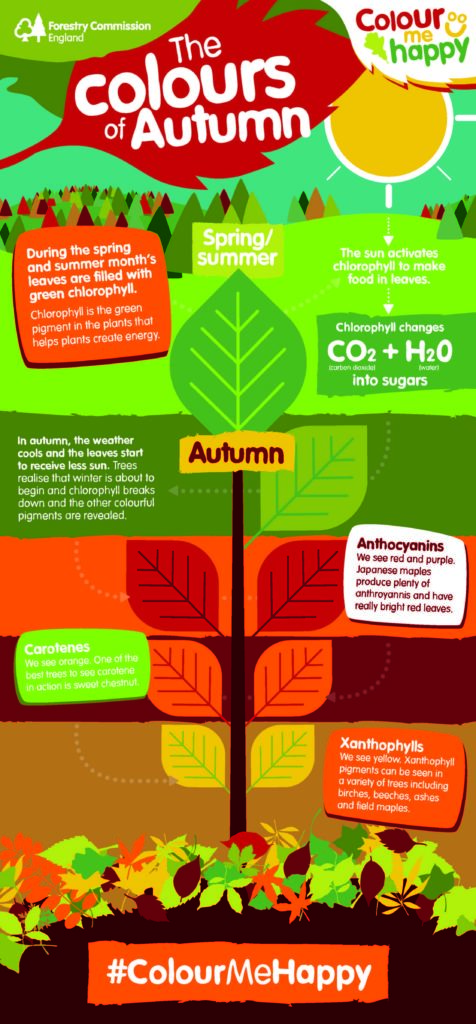Some plants have red leaves as a result of anthocyanin pigments, which protect the plant from sunlight damage or attract pollinators. Red leaves can also be a sign of stress or disease.
These pigments occur naturally in many plants and are often responsible for red or purple fruits, flowers, and fall foliage. Some examples of plants with red leaves include japanese maple trees, red cabbage, and red basil. The red coloration can change based on environmental factors such as temperature, light exposure, and nutrient availability.
While some gardeners select red-leaved plants for aesthetic reasons, others may need to monitor their plant for signs of stress or disease if the leaves start to turn red unexpectedly.

Credit: www.science-sparks.com
The Role Of Pigments In Plants
Explanation Of Chlorophyll And Its Importance
Chlorophyll is one of the most important pigments in plants, responsible for the green color we associate with healthy foliage. It plays a crucial role in photosynthesis, the process through which plants convert sunlight into energy and produce oxygen. Without chlorophyll, plants would not be able to make their own food, and the world would lack oxygen.
Introduction To Other Plant Pigments
While chlorophyll is the most widely recognized plant pigment, there are many other pigments that contribute to the range of colors we see in plants. These other pigments have functions beyond photosynthesis, such as helping to attract pollinators or protecting the plant from uv damage.
Focus On Anthocyanins And Their Role In Plant Biology
One of the most striking examples of a pigment beyond chlorophyll is anthocyanin, which is responsible for the red, orange, and purple colors in some plant leaves. While chlorophyll is necessary for photosynthesis, anthocyanins have other benefits for plants.
- Anthocyanins act as a sunscreen to protect foliage from harsh light, especially in high-altitude areas.
- They have antioxidant properties, helping to protect plant cells against damage from environmental stressors.
- In addition to protecting leaves, anthocyanins can also help attract pollinators through their bright colors.
Anthocyanins are produced by plants in response to stress, such as cold temperatures or drought, which can damage the plant. By synthesizing anthocyanins, plants can protect themselves and potentially attract helpful pollinators.
While chlorophyll is necessary for photosynthesis, other plant pigments like anthocyanins have important roles to play in plant biology. These pigments not only contribute to the beautiful colors we see in nature but also protect plants from environmental stress and help attract pollinators.
Factors That Impact Anthocyanin Production
Red leaves serve various purposes in plants such as attraction, stress response, and regulation of growth and development. The primary reason for the red color is the presence of anthocyanin pigment. What are the key factors that impact the production of anthocyanin?
Environmental Factors
Several environmental factors impact the production of anthocyanin in plants, such as:
- Temperature: Cooler temperatures can cause an increase in anthocyanin production, which is why many plants in colder climates produce red leaves.
- Light: Light intensity is a critical factor in anthocyanin production. High light intensity can cause an increase in pigment production while low light intensity can lead to a decrease in anthocyanin production.
- Water: Water stress can trigger the production of anthocyanin to make up for loss of chlorophyll.
- Nutrient availability: Availability of certain nutrients like nitrogen, phosphorus, and potassium influence production of anthocyanin in plants.
Genetic Factors
Besides environmental factors, plant genetics play a significant role in the pigmentation of leaves, flowers, and fruits. Some plants produce red leaves due to their genetic predisposition that results from:
- Mutation: Mutation in the genes responsible for chlorophyll synthesis can lead to plants producing red leaves due to the accumulation of anthocyanin.
- Inheritance: Inheritance or transfer of genes from parent to offspring determines plant pigmentation, and certain species have a higher probability of producing red leaves due to genetic inheritance.
Examples Of Plants That Produce Red Leaves
Some plants that produce red leaves are:
- Japanese maples (acer palmatum): This tree produces red leaves in spring and autumn, making it a popular choice for landscaping.
- Red cabbage (brassica oleracea var. Capitata): The pigment-producing anthocyanins in red cabbage give it a distinctive red color.
- Red elderberry (sambucus racemosa): The red leaves of this shrub are due to the presence of anthocyanin pigments.
- Field maple (acer campestre): Field maples are a species of maple tree that produces red leaves in the autumn.
Understanding the factors that impact anthocyanin production in plants helps us appreciate the science behind the beautiful and vibrant red leaves we see around us.
Benefits Of Red Leaves For Plants
Plants come in a wide array of colors, but have you ever stopped to wonder why some leaves are red? Sure, it might just be a cosmetic feature, but there is actually a scientific reason behind the diversity in plant color.
In this blog post, we’ll explore the benefits of red leaves for plants.
Protection From Uv Radiation
Red leaves might look pretty, but their function goes far beyond aesthetics. One of the primary benefits of having red leaves is protection from damaging ultraviolet (uv) radiation. Plants produce special pigments called anthocyanins, which absorb blue and green light, allowing the red pigment to be reflected back and protect the plant from uv damage.
But why is uv protection important? Just like sunburns on humans, overexposure to uv radiation can damage a plant’s dna and cause mutations that could potentially be harmful. By producing red leaves, plants are able to protect themselves from the sun’s harmful rays and prevent such damage from occurring.
Increased Visibility For Pollinators
Another benefit of red leaves is that they help pollinators find them more easily. Many insects, such as bees and butterflies, are attracted to brightly colored flowers, which serve as a source of food for them. Red leaves act in the same way as colorful flowers.
They help attract pollinators to the plant, ensuring successful pollination and reproduction.
Role In Stress Response
Red leaves also play an important role in a plant’s stress response. When a plant is exposed to stressful conditions, such as extreme temperatures or drought, it produces anthocyanin pigments. The red pigments help protect the plant from oxidative stress and damage caused by free radicals.
In addition, red leaves help regulate the plant’s photosynthesis and respiration, helping it survive under stressful conditions. By producing red leaves, plants are better equipped to cope with adverse environmental conditions and increase their overall resilience.
The benefits of red leaves for plants are many. From protection from uv radiation to increased visibility for pollinators to a crucial role in stress response, the diverse array of colors in plants serves a purpose far beyond mere aesthetics.
Frequently Asked Questions For Why Do Some Plants Have Red Leaves
Why Do Some Plants Have Red Leaves?
Plants with red leaves are often adapting to environmental stressors such as sunlight, cold weather, and drought. The red pigmentation helps to protect the plant’s chlorophyll and prevents further damage.
Are Red Leaves A Sign Of Disease?
Not necessarily. While some diseases can cause red or discolored leaves, red leaves are often a natural adaptation to environmental stressors and not a sign of disease.
Which Plants Have Red Leaves?
Plants with red leaves include the japanese maple, red cabbage, and copper beech tree, among others. Some plants may only have red leaves during certain seasons or under specific environmental conditions.
Does Red Pigment Affect Photosynthesis?
While red pigmentation can help protect a plant’s chlorophyll, it can also reduce the amount of sunlight absorbed and potentially affect photosynthesis. However, some plants have adapted to these conditions and can still photosynthesize effectively.
Can The Red Pigment Be Used In Other Ways?
Yes, the red pigment found in some plants can be used for various purposes such as natural dye, food coloring, and even in cosmetics. It can also be an indicator for environmental stressors in certain plants.
Conclusion
After delving into the various reasons why some plants have red leaves, it’s evident that this unique phenomenon is caused by several factors. The production of anthocyanin pigments is a major contributor, with variations in light exposure, temperature, soil acidity, and stress levels also playing important roles.
Additionally, red leaves are a key source of attraction for pollinators, acting as a visual cue for them to locate plants that are in bloom. As we continue to study the mechanisms behind red leaf formation, we gain a greater appreciation for the complexity of the natural world.
Whether for protection, adaptation, or simply aesthetic value, red-leafed plants have captured our attention and inspired curiosity for generations. As we move forward in our botanical explorations, the discovery of new species and the unraveling of mysterious plant traits will undoubtedly continue to fascinate and intrigue us.


